Ispaghula
| Home | | Pharmacognosy |Chapter: Pharmacognosy and Phytochemistry : Drugs Containing Carbohydrates and Derived Products
Ispaghula consists of dried seeds of Plantago ovata Forskal, belonging to family Plantaginaece.
ISPAGHULA
Synonyms
Ispaghula, Ispagol, Ishabgula, Spongel seeds.
Botanical Source
Ispaghula consists of dried seeds of Plantago ovata Forskal, belonging to family Plantaginaece.
Geographical Source
Ispaghula is an annual herb cultivated in India in Gujarat,
Maharastra, Punjab and in some parts of Rajasthan and Sindh Province of
Pakistan. It is cultivated extensively around Sidhpur in north Gujarat.
History
Blonde psyllium (Plantago
ovata) is a low herbaceous annual plant native to Iran and India,
extensively cultivated there and in other countries, including Pakistan. Black
psyllium of the P. afra species is
native to the western Mediterranean region, Northern Africa, and Western Asia,
now cultivated in Southern France and Spain. Black psyllium of the P. indica
species is native to Southeastern Europe and Asia. In commerce, blonde psyllium is obtained mainly from India, Pakistan,
and Iran. Black psyllium is obtained mainly from southern France.
Psyllium has a long history of medical use in both
con-ventional and traditional systems of medicine throughout Asia, Europe and
North America. Blonde psyllium is official in the National Pharmacopeias of
France, Germany, Great Britain, and the United States. Psyllium monographs also
appear in the Ayurvedic Pharmacopoeia, British Herbal Pharmacopoeia, British
Herbal Compendium, ESCOP Monographs, Commission E Monographs, and the German
Standard License Monographs. The World Health Orga-nization (WHO) has published
a monograph on psyllium seed covering P.
afra, P. indica, P. ovata, and P.
asiatica (WHO, 1999). Asian psyllium seed (P. asiatica Linn or P.
depressa Willd.) is official in the National pharmacopeias of China and
Japan.
Cultivation and Collection
Isabgol seeds are sown in the month of November by
broadcasting method. Well-drained loamy soil with a pH of 7.5–8.5, cool and dry
climate is suitable for its growth. Ammonium sulphate is also added as a
fertilizer. Good water supply to the plants is to be provided at 8–10 days
interval, seven to eight times. Though ispaghula is not affected by pests or
disease, the percentage yield is decreased to great extend due to heavy
rainfall or storms. The fruits are collected in the month of March/April after
the fruits are completely mature and ripe. The fruits are then dried and the
seeds separated.
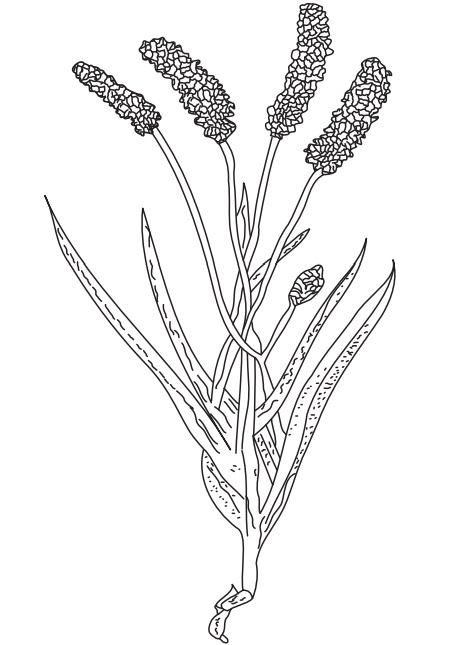
Morphology
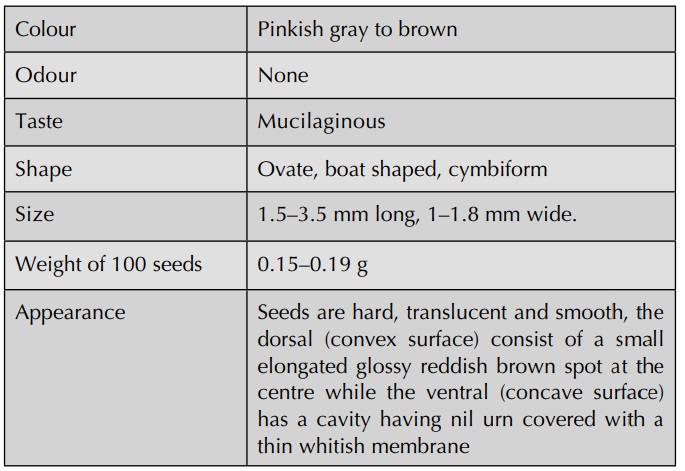
Microscopy
A thin transverse section observed under microscope shows
the following characters-
Epidermis: Single layered, thick walled
transparent, tangentially elongated cells containing mucilage, which exudes if
brought in contact with water.
Pigment Layer: Usually collapsed which is yellow in colour.
Endosperm: Outer layer consists of palisade
like cells which are thick walled but
inner cells are irregular and are also thick walled consisting of aleurone
grains and oil globules.
Embryo: Have two cotyledons, with three to
five vascular bundles in each, a portion of raphe remains attached to the
seed.
Chemical Constituents
Ispaghula seeds contain about 10% mucilage which is present
in the epidermis of testa. Mucilage consists of two complex polysaccharides, of
which one is soluble in cold water and the other soluble in hot water.
Chemically it is pentosan and aldobionic acid. Pentosan on hydrolysis yields
xylose and arabinose and aldobionic acid yields galactouronic acid and rhamnose.
Protein and fixed oil are present in endosperm and embryo.
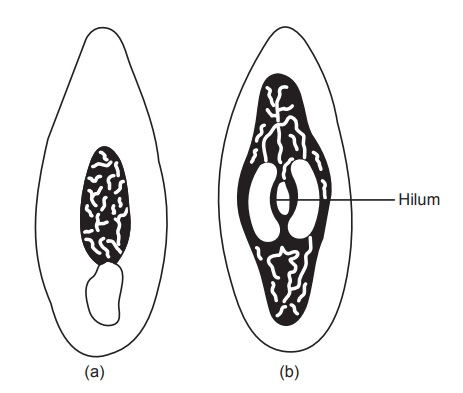
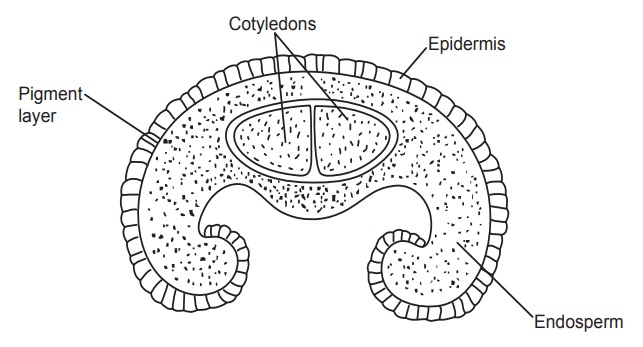
T.S. (schematic) of surface of ispaghula seed
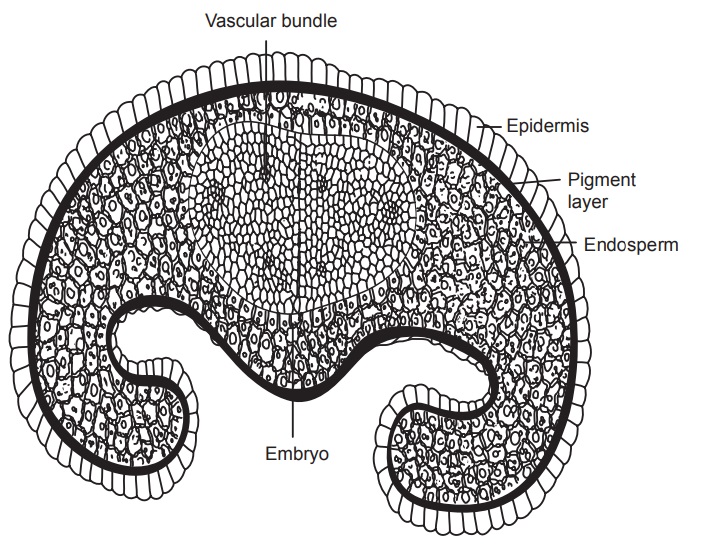
Transverse section of ispaghula seed
Chemical Tests
1. Ispaghula seeds when treated with
ruthenium red give red colour due to the presence of mucilage.
2. Add water to few seeds on a slide,
mucilage comes out and forms zone surrounding the seeds.
3. Swelling
factor: Swelling
factor is the parameter to determine the purity of seeds. Swelling can be
determined quantitatively by swelling factor. 1 g of the drug is put in a
measuring cylinder of 25 ml capacity and 20 ml water is added. It is shaken
periodically for first 23 h and kept for one more hour. The volume occupied by
the drug is called swelling factor. Swelling factor of ispaghula seeds is
10–13.
Uses
Ispaghula seeds are used as an excellent demulcent and bulk
laxative in chronic constipation. The laxative activity of ispaghula mucilage
is purely mechanical. It is also useful in dysentery, chronic diarrhoea, in
cases of duodenal ulcers and piles. It works effectively as a soothing agent.
Ispaghula husk is also used for similar purpose.
Substitutes and Adulterants
P. lanceolata Linn., occurring wild in India, is
adulterated in ispaghula. Its seeds
are oblong elliptical in shape with yellowish brown colour. The seeds of P. asiatica, (syn. P. major L.), found in Andhra Pradesh and Tamil Nadu, are
substituted to ispaghula. It is also adulterated with the seeds of P. arenaria.
The seeds of Salvia aegyptica are
frequently mixed which also yield
copious mucilage. The seeds of P. media
L. have different colour and swell very little in water.
P. asiatica contains mucilage which is composed
of β-1,4-linked D-xylopyranose residues having three kinds of branches.
Marketed Products
Sat Isabgol, Trifgol by Dabur, Sat-Isabgol by Dr Morepen.
